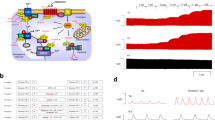Abstract
A possibility of in vivo formation of cyclic compounds between histamine (Hi) given i.p. and endogenous pyridoxal (PL) or pyridoxal 5′-phosphate (PLP) has been studied. Cyclic compounds of Hi with PL or PLP were found in all tissues examined. Although an increase in Hi levels in tissues enhances the formation of cyclic compounds, no simple relationship between the rate of formation and Hi concentration has been observed. The reaction seems to be limited by endogenous PLP. The cyclic products Hi-PL and HI-PLP were discovered in urine. It is suggested that the process of cyclic compound formation may reduce PLP resources, resulting in a modification of PLP-enzyme activities.
Similar content being viewed by others
References
J.T. Neary, R.L. Menecly, M.R. Grever andW.F. Diven,The Interactions between Biogenic Amines and Pyridoxal, Pyridoxalphosphate and Pyridoxal Kinase, Arch. Biochem. Biophys.151, 42–47 (1972).
R.W. Trewyn, K.D. Nakamura, M.L. O'Connor andL.W. Parks,An Interaction between S-Adenosyl- l -methionine and Pyridoxal 5′-Phosphate and its Effect on Saccharomyces cerevisiae, Biochim. Biophys. Acta327, 336–344 (1973).
Cz. Maśliński, D. Kierska andK. Kling,Selected Problems of Regulation of Biogenic Amines in the Body, Ann. Med. Sect. Pol. Acad. Sci.17, 167–183 (1972).
D. Kierska, K. Sasiak, M. Bogusławski andCz. Maśliński,Phosphopyridoxal Complexes with Histamine and Histidine. 1. The Kinetics of Complex Formation between Pyridoxal 5′-Phosphate and Histamine, Agents and Actions5, 15–19 (1975).
D. Kierska andCz. Maśliński,Phosphopyridoxal Complexes with Histamine and Histidine. 4. The Kinetics of Complex Formation between Histidine and Pyridoxal 5′-Phosphate in the Presence of Bacterial Histidine Decarboxylase, Agents and Actions5, 471–475 (1975).
K. Sasiak, D. Kierska andCz. Maśliński,Phosphopyridoxal Complexes with Histamine and Histidine. 5. The Kinetics of Cyclic Compound Formation between Histamine and Pyridoxal 5′-Phosphate in the Presence of Pig Kidney Diamine Oxidase and Rat Intestine Histaminase, Agents and Actions7, 19–25 (1977).
K. Wohl andCz. Maśliński,Phosphoryridoxal Complexes with Histamine and Histidine. 2. The Influence of Presumed Complex on Histidine Decarboxylase Activity in Rat Gastric Mucosa, Agents and Actions5, 20–24 (1975).
H. Honecker andH. Rommelspacher,Tetrahydronorharmane (Tetrahydro-β-Carboline) a Physiological Occurring Compound of Indole Metabolism, Naunyn-Schmiedebergs Arch exp. Path. Pharmak.305, 135–141 (1978).
C. Mytilineou, G. Cohen andR. Barrett,Tetrahydroisoquinoline Alkaloids: Uptake and Release by Adrenergic Nerves in vivo, Eur. J. Pharmac.25, 390–401 (1974).
C.J. Coscia, W. Burke, G. Jamroz, J.M. Lasala, J. McFarlane, J. Mitchell, M.M. O'Tode andM.L. Wilson,Oecurrence of a New Class of Tetrahydroisoquinoline Alkaloids in l -Dopa-Treated Parkinsonian Patients, Nature269, 617–619 (1977).
O.S. Lee, J.E. Mears, J.J. Bardin, D.D. Miller andD.R. Feller,Comparative Effects of Selected Tetrahydroisoquinoline (THI) Analogues in an α-and β-Adrenergic Receptor System, Fedn. Proc.32, 723 (Abs.) (1973).
W. Kehr, R. Horowski, H. Schulte-Sienbeck andK. Remse, Neuropharmakologische Untersuchungen eines neuen Antidopaminergen Tetrahydro-β-Carbolins, Arch. Pharm.311, 874–878 (1978).
Y. Nimitkitpaisan andP. Skolnick,Catecholamine Recptors and Cyclic AMP Formation in the Central Nervous System: Effects of Tetrahydroisoquinoline Derivatives, Life Sci.23, 375–382 (1978).
C.D. Wiener andM.L. Collins,Tetrahydroisoquinolines Derived from Catecholamines or Dopa: Effect on Brain Tyrosine Hydroxylase Activity, Biochem. Pharmac.27, 2699–2703 (1978).
A.C. Collins, I.L. Cashaw andN.E. Davis,Dopamine-derived Tetrahydroisoquinoline Alkaloids-Inhibitors of Neuroamine Metabolism, Biochem. Pharmac.22, 2337–2348 (1973).
M. Ebadi andP. Govitrapong,The Effect of Tetrahydroisoquinolone Derivatives on the Activity of Pyridoxal Kinase in Rat Brain, Fed. Proc.37, 276 (1978).
E. Kita, D. Kierska andCz. Maśliński,Synthesis and NMR Spectra of Tetrahydropyridoimidazole Compounds Derived from Pyridoxal 5′-Phosphate, Roczniki Chemii51, 1741–1745 (1977).
Author information
Authors and Affiliations
Rights and permissions
About this article
Cite this article
Kierska, D., Sasiak, K. & Maśliński, C. In vivo formation of histamine phosphopyridoxal cyclic compounds. Agents and Actions 11, 28–32 (1981). https://doi.org/10.1007/BF01991450
Issue Date:
DOI: https://doi.org/10.1007/BF01991450




